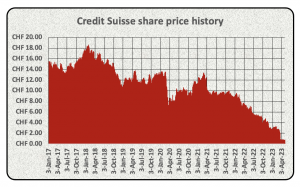I have decided to put my research into bank failures on hold for a while. Instead, I will share my thoughts on Andre′ de Ruyter’s book “Truth to power”. The publishing world clearly has not been collaborating about the timing of releases of non-fiction books in South Africa. There have been some crackers recently and all released within weeks of each other. Justice Malala’s book “The plot to save South Africa” provided some interesting facts regarding Chris Hani’s assassination back in 1993. The conspiracy theories surrounding this tragic event still circulate today. Michael Cardo’s book “Harry Oppenheimer Diamonds, gold and dynasty” is an enthralling biography. It should be on the reading list of undergraduate economics and politics students in South Africa. I am currently engrossed in Jonny Steinberg’s book “Winnie & Nelson, portrait of a marriage”. Phew, some explosive reveals in there.
De Ruyter’s book surreptitiously slipped into bookstores on 14 May 2023, apparently to avoid any preemptive action to prevent publication thereof. The first couple of chapters of “Truth to power” reminded my the infamous eye surgeon, lots of “I, I and I’s” in there and some curious management lessons. De Ruyter certainly won’t be sharing these management lessons in any of South Africa’s prestigious business schools any time soon – he may be assassinated upon venturing back into the rainbow nation. Page 95 of “Truth to Power” (yes, I purchased a hard copy of the book and did not access any pdf’s online) reveals a forensic investigator’s comment to De Ruyter in January 2020 “…Congratulations, you are now head of the largest organised crime syndicate in South Africa…”.
De Ruyter reveals a lot about the workings of ANC appointed members of parliament. Mantashe is lambasted for his obsession with coal and all things Russian. Gordhan’s reputation as one of the good guys and corruption busters also takes a serious knock. De Ruyter identified early on in his brief reign that Eskom needed to procure four to six additional gigawatts soon. Mantashe’s response to De Ruyter was “…stay in your lane..” whilst Pravin cautioned Andre′ “…you can’t say these things in public…”. It has become increasingly apparent to literate South Africans that the ANC is all about protecting it own turf at the expense of what may be good for the country. Barbara Creecy, the serving Minister of Environment, Forestry and Fisheries, apparently said to De Ruyter “…this loadshedding has nothing to do with Eskom…its all about politics in the run-up to the internal ANC election…”.
De Ruyter reveals that Mantashe was outflanked by Ramaphosa in July 2022. Ramaphosa had surprisingly lifted the cap on private generation of electricity to 100MW in June 2021. Mantashe remarked in July 2022 that despite lifting the cap on private generation there was not even a sign of 1 MW on the grid. Ramaphosa apparently immediately responded that perhaps the cap should then be lifted entirely. Mantashe is reportedly an enigma amongst foreign politicians and financiers. Eskom had managed to raise ±US$10 billion in climate financing deals during De Ruyter’s tenure despite the ANC’s forked tongues. “…Mantashe had a scathing interaction with a senior German minister, who made it clear that if South Africa was not prepared to play ball, the funding would be withdrawn. Bullying tactics aren’t a great way to persuade people to do business with South Africa. Privately, the funders expressed their cognitive dissonance to me, especially energy minster’s palpable hostility towards decarbonization. It was clear that government was suffering from what Aristotle called akrasia: the unerring propensity to always make the worst possible decision…”.
De Ruyter is pro renewable energy. He makes it clear that one of the reasons he took the Eskom head honcho position was to reduce South Africa’s dependence on coal. He makes strong statements such as “…The notion that we can release in the space of 250 years the carbon that has been trapped in fossil fuels over millennia, without it having any impact on our environment, surely borders on stupidity. The science is incontrovertible. Climate change caused by carbon emissions is a fact…”. Phew, the last time I heard such emphatic statements was during Covid-19 lockdowns exhorting us mere mortals to follow the science.
De Ruyter touches on something I have often pondered upon whilst imbibing the nectar of the gods. “…The intermingling of unions with government just doesn’t work. It can’t work because government can’t act against its own allies. Whoever cooked up that unholy alliance deserves to be locked in a room with Jim and Mabapa (union leaders of NUMSA and NUM respectively) for day or two…”. Interesting thought. A tripartite alliance between a purported liberation movement, trade unions and communists running a country? Wonder how that ends?
I wonder why De Ruyter decided to publish his recollections of his brief time at Eskom? Was it because of his perceived patriotic duty to wash dirty linen in public? Did big business look for a convenient spokesperson to reveal the rot of the ruling party? I guess motive doesn’t matter now. As they say in Afrikaans “uit, uit, die storie is uit”.
Stay safe out there and keep smiling. Hope is a wondrous thing.

 Hope to post soon about Silicon Valley Bank and First Republic Bank who have also gone out of business recently.
Hope to post soon about Silicon Valley Bank and First Republic Bank who have also gone out of business recently.
Recent Comments